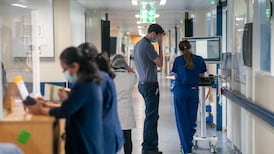Opticians will be unable to carry out full eye tests during a single appointment when they reopen on Monday, forcing patients to pay higher fees for routine care.
The Association of Optometrists Ireland (AOI) is also worried about an increase in common conditions which can cause blindness because people are afraid to visit opticians even as the coronavirus lockdown restrictions are eased.
Mark Daly, a former president of the association who runs practices in Dublin's Drumcondra and Sandymount, said health guidance for their reopening is "very restrictive".
“We’re going to find a lot of the regular examinations we do, we can’t do within the 15 minutes we’re allowed to stay within close proximity to the patient,” he said.
“We are going to have to bring them back to do a second appointment to finish certain things off. There are a number of examinations we could do within the 15 minutes, but in most cases we probably won’t be able to.”
The AOI confirmed this would mean extra fees, although it suggested these would be at a “reduced rate”. Medical card holders will be spared the additional costs.
Before the pandemic, full eye tests would typically take between 40 and 45 minutes. Because of social distancing and extra hygiene precautions, opticians expect they will now take about an hour.
Under the new regime, it is expected eye patients will will be interviewed for about 15 minutes by telephone before making a timed appointment to visit the optician in person. More triage – socially distanced – will be carried out in the practice before basic tests can begin.
Crucial devices
Measures to stem the spread of the coronavirus also effectively bar opticians from using some crucial devices for tests.
Many who used non-contact tonometers – which measure the internal pressure of the eye – will no longer be able to do so, because the pump of air from the machine causes particles to “fly all over the place”, said Mr Daly.
“If we can’t use that, we can’t check the pressure in the eye and pressure in the eye is very important for picking up things like glaucoma,” he said.
Glaucoma can lead to blindness if not diagnosed and treated early.
Opticians have also been ordered not to carry out ophthalmoscopy procedures, a routine part of eye examination involving the use of a special torch to look inside the eye.
“That brings us too close [to the patient] and there is the issue of particles in the air there as well. So we are not doing that,” said Mr Daly.
One alternative will be the use of digital photography to forensically examine the eye.
Furthermore, Mr Daly said he was concerned about late diagnosis of conditions – “which could get beyond control by the time they do come to us” – as he expects some people will stay away from eye tests over fears of contracting Covid-19.
Blindness
Macular degeneration ( a degeneration of the back of the eye), glaucoma and cataracts can all can cause blindness if not detected and treated in time.
“I would be worried there will be an increase in the number of these people,” Mr Daly said.
“I’d be afraid of people who will have sight-threatening conditions, that we could sort for them, that they wouldn’t come in.”
Sean McGrave, chief executive of the IOA, said he expects the “vast majority” of Ireland’s more than 350 opticians to reopen on Monday, but that some may stay shut over health concerns, lack of childcare or where part-time staff are better off on the emergency pandemic welfare payments.
Opticians “have been hurting” for the past eight weeks as they had “no income whatsoever” and were forced to pay out substantial sums for personal protective equipment, perspex screens, signage and other safety measures.
On the increased fees for patients forced to attend a second appointment, he said: “There will be some cases where we will have to get patients back in to complete tests. It wouldn’t be a full fee – it will be a reduced rate.”









